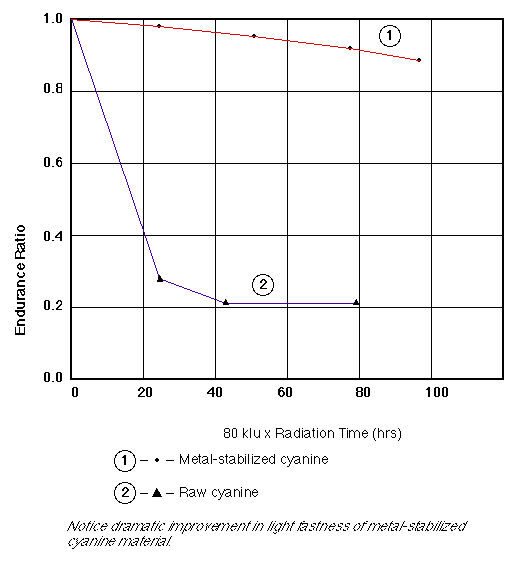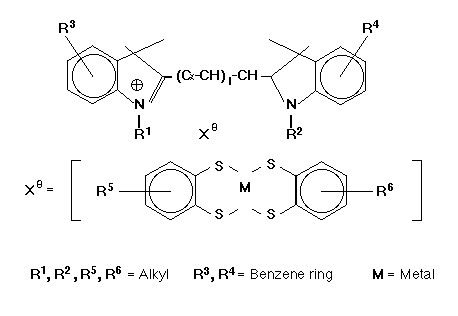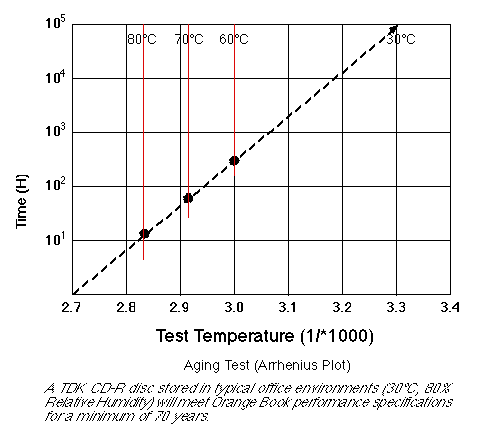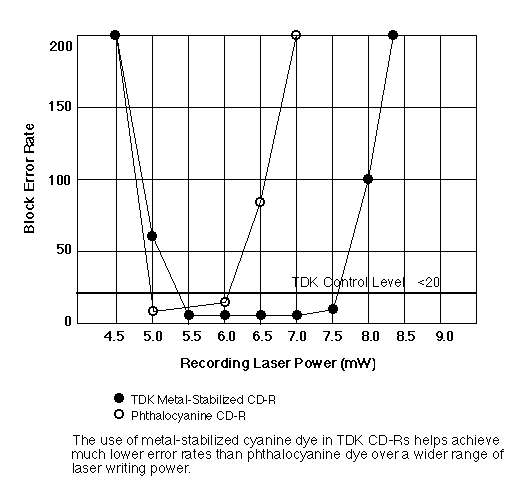Archival Lifespan of TDK CD-R
TDK rates the archival lifespan of its cyanine-based CD-R discs at 70 years (based on accelerated aging tests). This paper presents data that reflect TDK's decade-long research and development efforts in the field of optical recording media.
Raw Cyanine v. Metal-Stabilized Cyanine
The following graph (Fig. 1) shows very clearly that raw cyanine dye is a terrible material to use in the recordng layer of a CD-R. That's because raw cyanine is far too sensitive to light. Even a brief exposure to a Xenon test lamp (at a power of 80 klux) is sufficient to break its molecular bonds and render it unusable.

Figure 1: Light Fastness of Raw Cyanine and Metal-Stabilized Cyanine
What's needed is a way to stabilize the cyanine dye -- tuning it for optimum sensitivity at specific laser wavelengths and powers while minimizing its overall light reflectivity. It was TDK's original research in this area that resulted in the creation of a new type of metal-stabilized cyanine material (Fig. 2). The addition of a metal compound to the "raw" cyanine dye changes the material completely -- giving it a tremendous degree of light "fastness" while preserving its sensitivity to lasers at a range of writing powers. A glance at Figure 1 again shows this difference quite dramatically.

Figure 2: Molecular Structure of TDK Metal-Stabilized Cyanine Dye
Accelerated aging test results for TDK CD-R are presented in Figure 3. The graph looks complex, but it's not. Basically, it shows the expected life span of a TDK CD-R at various storage temperatures. You'll notice that we specify our media for a lifespan of more than 70 years when stored at a temperature of 30° Centigrade -- about 86 ° Fahrenheit. This test procedure and the performance specifications it is based on are outlined in an ANSI document.

Figure 3: Accelerated Aging Test -- TDK CD-R74 Disc
A glance at Figure 3 discloses that longevity is severly compromised at, say, a temperature of 80° Centigrade -- about 176° Fahrenheit. Excessive heat is something that users of all CD-Rs -- cyanine or phthalocyanine -- should guard aginst. The importance of maintaining controlled "room temperature" storage for all types of media is something that professional recordists have long recognized, and which we reiterate in the precautions statement that comes with our CD-Rs.
Regarding the assertion that cyanine CD-Rs will expire if left "dye-side-up; on a desk near a window over a sunny weekend," nothing could be further from the truth. This conclusion may be based on erroneous expectations of the medium's light sensitivity or its heat sensitivity.
At TDK's research and development center we attempted to gauge the impact that direct exposure to sunlight would have on CD-R media -- both cyanine and phthalocyanine type discs. A weekend's worth of longevity is obviously not what we were after, so our test protocol was far more demanding. In fact, Table 1 shows the impact on both cyanine and phthalocyanine discs after their dye sides have been exposed to 2 years worth of sunlight passing through a window in the Netherlands (home base of Philips). This is equivalent to a requirement specified in the Orange Book Part II.
|
Test Disc |
TDK Metal-Stabilized Cyanine CD-R |
Phthalocyanine CD-R |
Orange Book II |
||
|
Items |
Initial |
4.0 Mlux*h |
Initial |
4.0 Mlux*h |
Spec Level |
|
A top (%) |
70.0 |
85.8 |
68.8 |
85.5 |
>85 |
|
I11 mod. (%) |
82.9 |
88.3 |
72.8 |
72.3 |
>80 |
|
I 3 mod. (%) |
40.5 |
48.8 |
40.4 |
39.5 |
30 to 70 |
|
Asymmetry (%) |
-3.8 |
-11.3 |
-3.8 |
-2.8 |
-20 to +20 |
|
Land Jitter (ns) |
24.5 |
26.5 |
17.0 |
18.8 |
<35 |
|
Pit Jitter (ns) |
21.1 |
17.5 |
15.2 |
16.5 |
<35 |
|
Cross-talk (%) |
27.1 |
40.3 |
23.4 |
26.6 |
<50 |
|
NPPR |
0.57 |
0.52 |
0.54 |
0.65 |
0.5 to 1.0 |
|
BLER (1/7350) |
3.3 |
9.8 |
1.3 |
1.4 |
<220 |
Test condition: Xenon Lamp Strength = 80 klux. Test Radius = 27mm. Orange Book requirement is equivalent to 4 Mlux*h at 40°C or lower
With their dye sides exposed to the equivalent of 2 years of sunlight passing through a glass window in the Netherlands, both TDK metal-stabilized cyanine CD-R and typical phthalocyanine-type CD-R remain within Orange Book Part II performance specification.
In each performance parameter -- jitter, cross-talk, BLER, etc. -- both the cyanine and phthalocyanine media stay well within Orange Book performance specifications. You may note that in some cases the performance of phthalocyanine media exceeds that of our cyanine-based discs, and these differences -- though insignificant in terms of media reliability -- do point up a difference between the two dye chemistries. Namely, phthalocyanine is slightly more resistant to light than our stabilized cyanine formulation. In fact, the increased resistance to light does give phthalocyanine discs an edge in archival lifespan; manufacturers of phthalocyanine media can spec their discs at 100 years, we spec a minimum of 70 years.
So Why Use Cyanine?
This is the key question: why does TDK use stabilized cyanine dye? The answer is to ensure compatibility with your CD recorder and long-term writable. To understand this, take a look at Figure 4. It shows the block error rates generated over a broad range of laser writing powers with both TDK's stabilized cyanine dye media and typical phthalocyanine dye media.

Figure 4: CD-R Block Error Rates at Various Laser Powers
You'll note that TDK media maintains its low error rates over a very broad range of laser power: 6.5 mW +/- 1.0 mW. Phthalocyanine, however, is very specific in its power requirement; a CD recorder tuned to 5.5 mW can deviate no more than 0.5 mW to achieve the same low error rates.
If laser diodes never aged, it all recorder manufacturers guaranteed that every diode that left their factories was 100% locked to a specific power output and if every studio owner could ensure that only one type of CD-R would ever be used in their facility, then phthalocyanine media would have a performance edge after 70+ years of storage. But that's not the real world.
In the real world, it's not uncommon to find factory-fresh CD recorders generating higher or lower power outputs than the nominal manufacturer spec at 1x, 2x, 4x and 6x recording speeds. Moreover, CD recorders cannot be expected to maintain precise power conditions over the entire surface of the disc under a wide range of operating temperatures.
In this context, TDK chose to create a dye material that would perform ideally in the broadest possible range of recorders operating at all recording speeds over the widest possible time period. That's the kind of decision that a company with more than 35 years of recording media experience is expected to make -- a decision that reflects our understanding of the needs of critical professional users.
In this open letter, we have done our part to clarify the situation with basic facts about TDK CD-R metal-stabilized cyanine technology.

